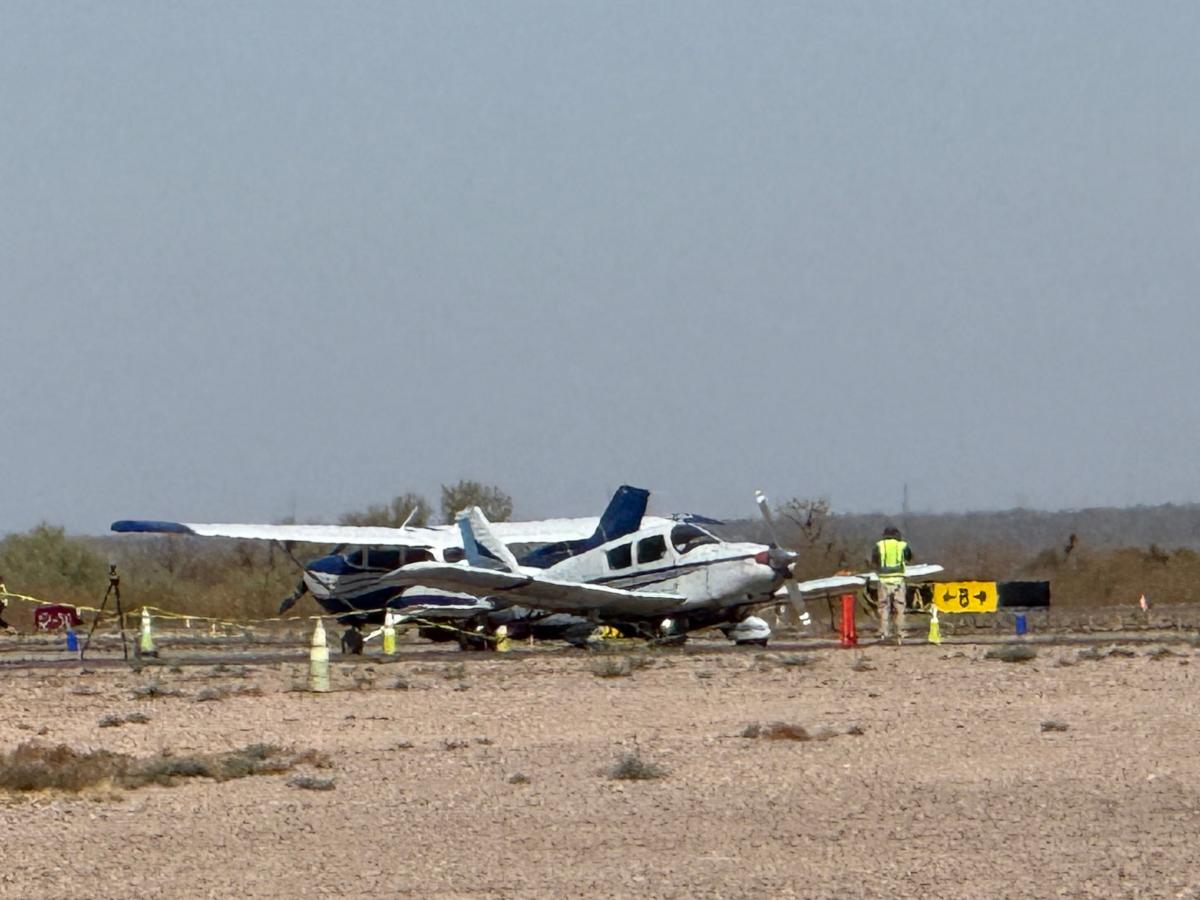
Flight instructor Erwin Castillo was in the air teaching a student to fly when, over his radio, he heard, “Mayday! Mayday! Mayday!”
A moment later, Castillo looked out the window of his aircraft and saw smoke billowing from the Marana Regional Airport. He realized a plane had crashed.
Two people were killed Wednesday in the midair collision involving two small planes, a Cessna 172S and a Lancair 360 MKII, officials said. The Federal Aviation Administration and the National Transportation Safety Board were investigating the collision. The two people who died in the crash had not yet been identified by authorities.
Advertisement
Advertisement
In an interview, Castillo described the harrowing radio call he heard and the conversation he had with the pilot of the Cessna, which landed safely after the midair collision.
The collision occurred about 8:28 a.m. Wednesday, the NTSB said. The weather was clear, with calm winds that day.
Castillo said he was giving a flying lesson over the Silver Bell practice area west of the Marana airport when he heard a radio call from the Lancair saying he was “going to go around again.”
Castillo said the tone of the man’s voice on the radio call caught his attention.
“That’s odd. He sounds pretty upset,” Castillo recalls thinking.
Advertisement
Advertisement
About five seconds later, Castillo said he heard someone “screaming” over the radio, and then “He just hit us. Mayday! Mayday! Mayday. We are going to turn around and land on runway 3-0.”
After that, Castillo heard the same voice say, “Airplane down. Airplane down.”
Castillo said he radioed the pilot of the Cessna and asked if help was needed. The pilot radioed back that she had the plane under control, Castillo said. Castillo then radioed the airport, “Hey. There is a plane down. They need assistance.”
The Cessna managed to land safely, authorities said. The Cessna was operated by the Chandler location of AeroGuard Flight Training Center, a flight school, a spokesperson confirmed to The Arizona Republic.
Advertisement
Advertisement
More in U.S.
Castillo said he spoke with the Cessna’s pilot after landing.
Castillo said the Cessna’s pilot told him she was practicing “touch and go’s” with a student when the Lancair approached from behind the Cessna and attempted to land. A touch and go is an aviation maneuver in which a pilot lands and takes off without stopping.
When the Lancair‘s pilot saw the Cessna below, the Lancair attempted to fly around again. As the Cessna was taking off, the Cessna’s propeller “hit the Lancair’s tail,” Castillo said.
Castillo said he saw the Cessna’s propeller was bent after landing.
The FAA posted on its website Thursday the Cessna was on approach when it was struck from behind by the Lancair.
Advertisement
Advertisement
“Everybody says the Lancair hit that plane, but it’s actually the other way around. The Cessna hit the Lancair’s tail, and that is what caused the Lancair to crash,” Castillo said.
Castillo said because the pilot of the Cessna was taking off, the Cessna had the right of way.
“The Lancair should have avoided it. It should have either slowed down or climbed higher. But that didn’t happen,” Castillo said. “He should have flown over them. And the Cessna hit him, causing him the crash.”
The Lancair is a single-engine, two-seat amateur-built airplane, according to the FAA. The plane was registered to Michael Reinath of Rio Vista, California, according to the FAA.
Advertisement
Advertisement
Castillo has been a pilot for 16 years and a flight instructor for four. He works for IFLY Flight School, based at the Marana Regional Airport.
Castillo said he was shaken up by the two deaths, as was the pilot of the Cessna.
“It’s really sad,” Castillo said.
Castillo believes the midair collision showed the airport needs a staffed air traffic control tower.
“It’s a very busy airport,” Castillo said.
Castillo said the protocol is for pilots to “self-announce” their position to other pilots. Pilots are supposed to shift to the right if they see another plane to keep the other plane in view from the left window, Castillo said.
Advertisement
Advertisement
In 2024, the Marana airport logged 85,000 operations, including takeoffs, landings and touch-and-goes, Vic Hathaway, the town’s communication manager, said.
The Marana Regional Airport does not have an air traffic control tower, the FAA said.
A crewed tower was supposed to be in place by the end of 2024 to accommodate an increase in traffic and improve safety. The completion of the tower was pushed back because of supply chain and other problems related to the COVID-19 pandemic, said Vic Hathaway, communications manager for the town of Marana.
This article originally appeared on Arizona Republic: ‘Mayday, mayday’: Pilot describes Marana airport fatal collision
EMEA Tribune is not involved in this news article, it is taken from our partners and or from the News Agencies. Copyright and Credit go to the News Agencies, email news@emeatribune.com Follow our WhatsApp verified Channel



